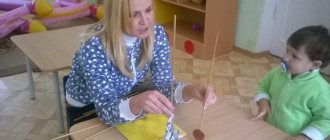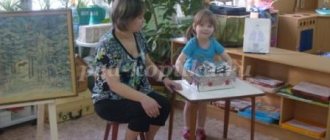“Tell a fairy tale from a picture” Goal: To develop the ability to retell a familiar fairy tale based on illustrations. Equipment: Plot pictures for fairy tales or a series of plot pictures. Progress of the game: The teacher shows the child a story picture. The child names the fairy tale and describes what is depicted in it. If desired, the child can tell the story in full. “Who is the extra character?” Goal: To clarify children’s knowledge of the content of fairy tales and fairy-tale characters. Equipment: figurines of fairy tale heroes from various types of theater. How to play: The heroes of one of the fairy tales with one extra character are placed on the table. For children 5 years old, it's called a fairy tale. Children must name who is extra, who is lost. Children after five years old must name which fairy tale the heroes are from and who is lost. Lotto “Find fairy-tale characters” Goal: To develop the ability to recognize a fairy tale and its characters. Equipment: Large cards with the plot of a fairy tale; small cards depicting fairy-tale heroes of a fairy tale Game progress: Children have large cards with the plot of a fairy tale. The presenter shows small cards. The child, who has a hero from a fairy tale depicted on a large card, names the hero and takes him for himself. The first one to fill out his card wins. “Who gets it together faster” Purpose: To consolidate the content of fairy tales. Equipment: Figures of fairy-tale characters, illustrations of fairy tale plots. How to play: The plots of different fairy tales are laid out on the tables. Children are given figurines or illustrations of fairy-tale characters. Children dance to the music with their characters. At the teacher’s command, children find the desired plot and pose their own fairy-tale hero. “Name a fairy tale” Purpose: To consolidate the content of fairy tales and fairy-tale characters. Equipment: A playing field on which the plots of different fairy tales are placed in turn; cube. Progress of the game: The child throws the dice. Makes a move in accordance with the dropped number of points. Names the fairy tale he fell into and its characters. If he succeeds, he continues the game in order of priority. If he fails, he returns to the start. "What changed?" Goal: To consolidate the ability to distinguish and name fairy tale characters. Equipment: figures (illustrations) from a tabletop theater, from one or more fairy tales (complication). How to play: In front of the children are figures of heroes from one fairy tale (or from several). The names of the heroes are clarified. Then the children close their eyes and the teacher removes one toy. Children open their eyes and have to say what has changed. “Guess the fairy tale” Purpose: To consolidate the names of fairy tales and fairy-tale characters. Equipment: Cards depicting an excerpt from a fairy tale or a fairy-tale character. Progress of the game: the cards are turned over, the children come up in turn, choose a card, name a fairy tale or a character. If the answer is correct, the card is taken away; if not, it is put back in its place. At the end of the game, the winning cards are counted.
Aren't you tired? Then let's play some more!
Educational games for children 5 - 6 years old based on fairy tales
Educational games for children 5 - 6 years old based on fairy tales
Author: Eremina Anastasia Nikolaevna, preschool teacher, teacher at GBDOU kindergarten No. 14, St. Petersburg.
The games are designed for preschool children, educators, speech therapists, and psychologists.
“Through a fairy tale, fantasy, play, through unique children’s creativity - the right path to a child’s heart,” wrote V. Sukhomlinsky. A fairy tale is an amazingly powerful psychological tool for working with a child’s inner world, a powerful development tool. Fairy tales, introducing children to the circle of extraordinary events and transformations that occur with their heroes, express deep moral ideas. They teach kindness towards people, show high feelings and aspirations. K.I. Chukovsky wrote that the goal of a storyteller, and first of all a folk storyteller, is “to cultivate humanity in a child - this marvelous ability of a person to worry about other people’s misfortunes, to rejoice at the joys of another, to experience someone else’s fate as if it were his own.” Objectives: - Repeat and consolidate concepts about folk and literary fairy tales; — Continue enriching children’s vocabulary with new words; — To make children want to help the heroes of fairy tales; — To cultivate in children a love for folk and literary fairy tales of various types; — Develop speech, imagination, fantasy, thinking. GAME 1. “What kind of fairy-tale hero?” Assignment: Some fairy-tale heroes have double names.
I will tell you the first part of the name, and you try to guess which fairy-tale hero we are talking about. Koschei the Deathless)
Boy - ... (with a finger)
Brother - ... (Ivanushka)
Ivan Tsarevich)
Dragon)
Elena - ... (Wise)
Sister - ... (Alyonushka) Vasilisa - ... (Beautiful)
Tiny - ... (Khavroshechka)
Princess Frog)
GAME 2. “Make up a fairy tale.” Assignment: Children, using cards-schemes, sequence the chain of heroes of the fairy tales “Teremok”, “Turnip”, “Zayushkina’s hut”, “Kolobok”. *TEREMOK - mouse-norushka, frog-frog, bunny-runner, fox-sister, top-gray-barrel, club-toed bear. *Turnip - grandfather, grandmother, granddaughter, Bug, cat, mouse. *Zayushkina's hut - dogs, wolf, bear, rooster.
*Kolobok - hare, gray wolf, bear, fox. GAME 3. “Magic objects.” Assignment: fairy-tale characters have magical objects that help them create magic. Names magic objects or magic words, and the children name the owner of this magic. Mortar and broom. (Baba Yaga)
“At the behest of the pike, at my will... (Emelya)
Magic wand. (Fairy from the fairy tale “Cinderella”)
Walking boots. (Puss in Boots) · Hair from a beard. (Old Man Hottabych)
· Ring. (Vanya from the fairy tale “The Magic Ring”)
· Tsvetik-Semitsvetik (Zhenya, fairy tale “Tsvetik-Semitsvetik”)
· Invisible hat (Ivan, “The Tale of Ivan Tsarevich”)
We recommend watching:
Mathematical game with Cuisenaire sticks for children 5-6 years old Scenario of a game program based on fairy tales in kindergarten for the middle group Didactic games for children 6 - 8 years old based on fairy tales Game based on fairy tales for children of the senior preparatory group
Similar articles:
Game "Cabbage" for older children
Spring games for older children in kindergarten
Games for the development of fine motor skills for children 5-6 years old in kindergarten
Games for the development of logical thinking for children 5-6 years old in kindergarten
Literacy games for children 5-6 years old in kindergarten




